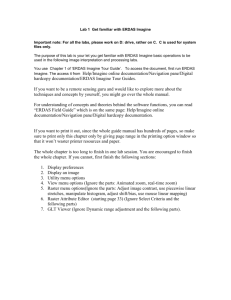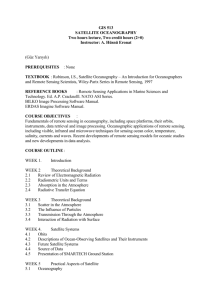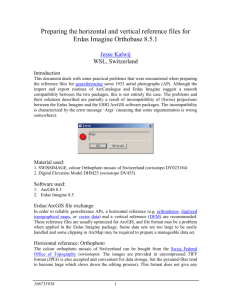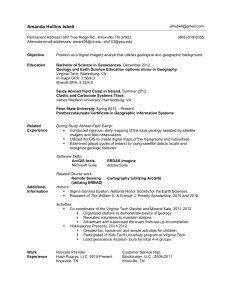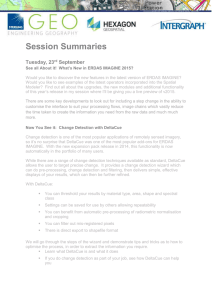INTEGRATED PLATFORM DESIGN AND REALIZATION OF LAND USE CHANGE
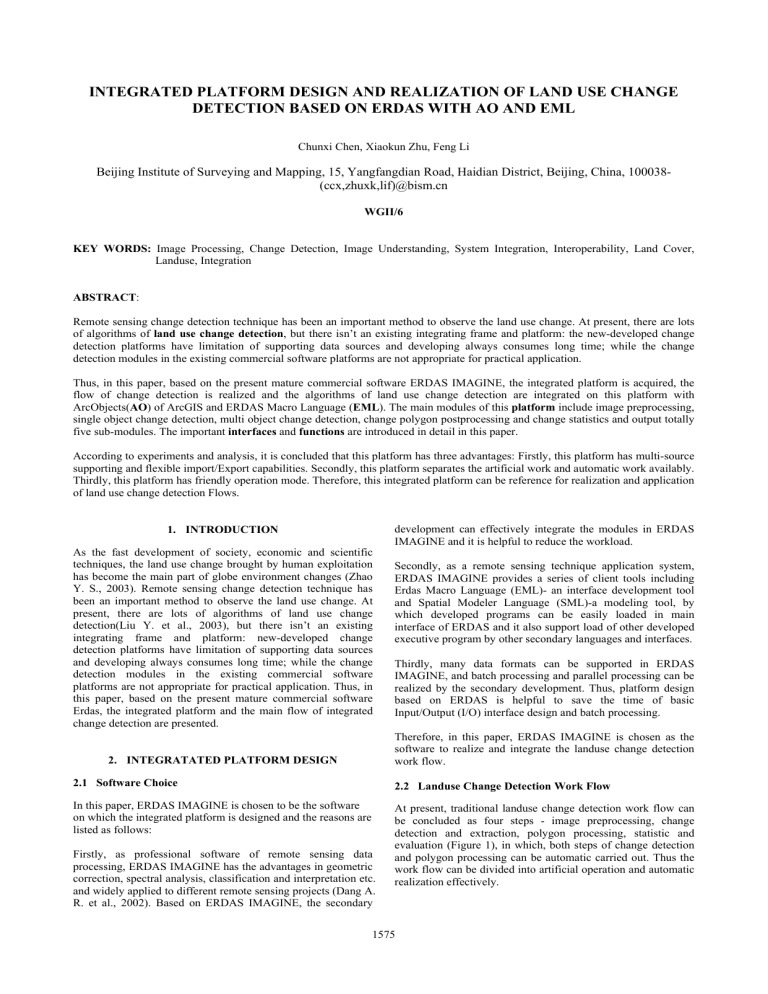
INTEGRATED PLATFORM DESIGN AND REALIZATION OF LAND USE CHANGE
DETECTION BASED ON ERDAS WITH AO AND EML
Chunxi Chen, Xiaokun Zhu, Feng Li
Beijing Institute of Surveying and Mapping, 15, Yangfangdian Road, Haidian District, Beijing, China, 100038-
(ccx,zhuxk,lif)@bism.cn
WGII/6
KEY WORDS: Image Processing, Change Detection, Image Understanding, System Integration, Interoperability, Land Cover,
Landuse, Integration
ABSTRACT :
Remote sensing change detection technique has been an important method to observe the land use change. At present, there are lots of algorithms of land use change detection , but there isn’t an existing integrating frame and platform: the new-developed change detection platforms have limitation of supporting data sources and developing always consumes long time; while the change detection modules in the existing commercial software platforms are not appropriate for practical application.
Thus, in this paper, based on the present mature commercial software ERDAS IMAGINE, the integrated platform is acquired, the flow of change detection is realized and the algorithms of land use change detection are integrated on this platform with
ArcObjects( AO ) of ArcGIS and ERDAS Macro Language ( EML ). The main modules of this platform include image preprocessing, single object change detection, multi object change detection, change polygon postprocessing and change statistics and output totally five sub-modules. The important interfaces and functions are introduced in detail in this paper.
According to experiments and analysis, it is concluded that this platform has three advantages: Firstly, this platform has multi-source supporting and flexible import/Export capabilities. Secondly, this platform separates the artificial work and automatic work availably.
Thirdly, this platform has friendly operation mode. Therefore, this integrated platform can be reference for realization and application of land use change detection Flows.
1.
INTRODUCTION development can effectively integrate the modules in ERDAS
As the fast development of society, economic and scientific techniques, the land use change brought by human exploitation has become the main part of globe environment changes (Zhao
Y. S., 2003). Remote sensing change detection technique has been an important method to observe the land use change. At present, there are lots of algorithms of land use change detection(Liu Y. et al., 2003), but there isn’t an existing integrating frame and platform: new-developed change detection platforms have limitation of supporting data sources and developing always consumes long time; while the change detection modules in the existing commercial software platforms are not appropriate for practical application. Thus, in this paper, based on the present mature commercial software
Erdas, the integrated platform and the main flow of integrated change detection are presented.
2.
INTEGRATATED PLATFORM DESIGN
2.1
Software Choice
IMAGINE and it is helpful to reduce the workload.
Secondly, as a remote sensing technique application system,
ERDAS IMAGINE provides a series of client tools including
Erdas Macro Language (EML)- an interface development tool and Spatial Modeler Language (SML)-a modeling tool, by which developed programs can be easily loaded in main interface of ERDAS and it also support load of other developed executive program by other secondary languages and interfaces.
Thirdly, many data formats can be supported in ERDAS
IMAGINE, and batch processing and parallel processing can be realized by the secondary development. Thus, platform design based on ERDAS is helpful to save the time of basic
Input/Output (I/O) interface design and batch processing.
Therefore, in this paper, ERDAS IMAGINE is chosen as the software to realize and integrate the landuse change detection work flow.
2.2
Landuse Change Detection Work Flow
In this paper, ERDAS IMAGINE is chosen to be the software on which the integrated platform is designed and the reasons are listed as follows:
Firstly, as professional software of remote sensing data processing, ERDAS IMAGINE has the advantages in geometric correction, spectral analysis, classification and interpretation etc. and widely applied to different remote sensing projects (Dang A.
R. et al., 2002). Based on ERDAS IMAGINE, the secondary
At present, traditional landuse change detection work flow can be concluded as four steps - image preprocessing, change detection and extraction, polygon processing, statistic and evaluation (Figure 1), in which, both steps of change detection and polygon processing can be automatic carried out. Thus the work flow can be divided into artificial operation and automatic realization effectively.
1575
The International Archives of the Photogrammetry, Remote Sensing and Spatial Information Sciences. Vol. XXXVII. Part B7. Beijing 2008 d.
e.
Based on this workflow division, the main interfaces and modules of integrated platform are fulfilled.
2.3
Figure 1. Work Flow of Landuse Change Detection
Interface Design with EML
EML, as a kind of macro language supported by ERDAS, is applied to defining the client interface structure and content. It can provide some edit capabilities of basic process (Liu J. J. et al., 2003, Programming Reference Guide-Erdas Macro
Language). Interface designs with EML include ERDAS standard Graphical User Interface (GUI) modification and self-definition of individual GUI these two methods. In detail, modifying the file “Imagine.eml” in “$Imageine Home/Script” can be applied to adding the controls of GUI and the follow
GUI interface could be acquired(Figure 2): a.
b. c. f.
Figure 2. Main Interface of Landuse Change Detection
The main interface(Figure 2.a) of this integrated platform is added to ERDAS. By choosing “Change Detection” icon, change detection tool set module can be used(Figure 2.b). In this module there are four sub-modules including preprocessing sub-module (Figure 2.d), change detection and extraction sub-module (Figure 2.c), polygon processing sub-module
(Figure 2.e), statistics and evaluation sub-module (Figure 2.f).
All the module interfaces are designed with EML.
2.4
Sub-Module Functions
1) Preprocessing Sub-module
The useful functions in ERDAS are integrated by EML, including format transforming, subseting, image geometric correcton, mosaicing, projecting, image fusion, band composition, histogram matching and median filter. In detail, these functions can be loaded by main module program, for example format transformation is realized by “on mousedown load”import.eml””(Wang J. X. et al., 2006), the function interfaces are same as those of ERDAS and are available to centralize the preprocessing operation.
2) Change Detection and Extraction Sub-module
The development is carried out with EML. The traditional landuse change detection methods include image difference, spectral feature variation, color composition and post-classification difference and the work flows of all the methods from histogram matching, change detection to threshold extraction can be antomatically executed.
3) Polygon Processing Sub-module
The development is carried out with EML and AO. With AO, the polygon processing functions are produced as “*.exe” and added into the main integrated platform. With AO the secondary development functions contain polygon filling, polygon rectangular range acquiring and polygon vectorization(to shapeFile and DWG).
4) Statistics and Evaluation Sub-module
This module realizes the accuracy analysis and change area statistic functions, in which the accuracy analysis makes use of
1576
The International Archives of the Photogrammetry, Remote Sensing and Spatial Information Sciences. Vol. XXXVII. Part B7. Beijing 2008 the Accuracy Assessment function of ERDAS IMAGINE with
EML. The change area statistics function is carried out with AO and added into the main integrated platform in the form of
“*.exe”.
2.5
Module Development and Realization
2.5.1
Module Development with EML
Image differencing method is realized with EML and the main function and interface are listed as follow:
1) Realization of two operational modes. One is middle input/output; the other is automatic flow processing.
In Figure 3, for the first mode, after every output box there is a button ”OK”, which is helpful to single processing and output.
If you want to input a middle file, you can choose the diamonds after the output names and press the relative buttons “OK”.
Diamonds
OK button
Batch button
Figure 3. Two Modes
Considering the input and output box types in ERDAS are different, the key technique for the middle control processing is setting two type boxes at the same location and with a diamond to control which type of box displays.
In second mode, the processing dialog has a batch processing button in the end, which executes the workflow to end at once with the original images and parameters input.
For histogram matching, image difference, principle component transformation and threshold extraction, in ERDAS, there are already different models. In order to undo the relative repeated work, integrating these models is chosen to realize the workflow.
The parameters of every model are separated, some parameters are fixed for user, and all the interfaces are integrated in one
GUI interface.
2) Realization of synchronous display
The meternumber and viewer control in EML are applied to thereshold extraction and synchronous display (Figure.4). As the threshold changes, the viewer displays different results relatively.
Figure.4 Realization of Synchronous Display
2.5.2
Module Development with AO
Polygon processing method is realized with AO and the main function and interface are listed as follow:
1) Module development with AO
Module development with AO (ArcGIS Develop Help-VB6,
Zhao W. F. et al.., 2004) is helpful to make good use of the main function of ArcGIS, such as polygon vectorization (to shapeFile) which cites the IConversionOp interface and
RasterDataToPolygonFeatureData of AO. Based on VB environment, the “shape.exe” executive program is acquired.
2) Embedding program
Under the EML environment, by “ on mousedown
{"own/toshape.exe";} ” the AO functions can be loaded.
3.
EXPERIMENTS AND ANALYSIS
3.1
Experiment
On the integrated platform mentioned above, integration of the automatic processing work flow and fast processing are realized.
TM satellite images in Beijing acquired in 2004 and 2005 are applied to landuse change detection experiments of the integrated platform to test its efficiency. the processing time comparative results are listed in Table.1.
Image
Differen- ce
Spectral
Feature
Variation
Steps
No Use
Platform
Preprocessing
Chang
Detection
Threshold
Extraction
Classification
Extraction
Polygon
Processing
Use
Platform
Differ- ence
Preprocessing
Chang
Detection
Threshold
Extraction
1 1 0
Classification
Extraction
Polygon
Processing
25 25 0
10 4 -6
Evaluation 30 30 0
30 30 0
12 5 -7
1577
The International Archives of the Photogrammetry, Remote Sensing and Spatial Information Sciences. Vol. XXXVII. Part B7. Beijing 2008
Post-classi- fication difference
3.2
Color
Compo- sition
Evaluation 30 30 0 ACKNOWLEDGEMENTS
Chang
-3.5
-21.4
Preprocessing 3 1.1 -1.9
Zhou Xiao for valuable comments and suggestion.
1.5 1.5 0
Detection
Artificial
REFERENCES:
Extraction
60 60 0
Evaluation 30 30 0
Zhao Y. S., 2003. Remote Sensing application Analysis
Principle and Methods. Beijing Science Pulishing House.
Liu Y., Zhang J.X.,Ling Z.J.,2003. Change Information
Classification
Extraction Method Research on landuse Dynamic Remote
Extraction
Sensing Monitoring. Remote Sensing Information , (1),pp.21-24.
Polygon
Processing
Dang A. R., Wang X. D., Chen X. F., 2002, et al. Erdas Imagine
Evaluation 30 30 0
Remote Sensing Image Processing Method. Tsung Hua
University Human Living and Environment Center.
Result analysis
Table 1. Change Detection Efficiency Comparative Table
(unit-minites)
Liu J. J., Jia Y. H., Ke M. Z.,2003, The Secondary Development and Client Method Research. Geometric Spatial
Information ,1(4),pp.29-33.
Programming Reference Guide-Erdas Macro Language.
Wang J. X., Song W. D., Hong Z.,2006. Application of Spatial According to experiments, it is concluded that:
1) The efficiencies of the change detection methods mentioned above without the integrated platform are higher than those with the integrated platform. Based on the reduced time in order from high to low, they are post-classification difference, spectral feature variation, image difference, and color composition in turn.
2) During the change detection and extraction step, the efficiencies of change detection, threshold extraction and
Modelling in Remote Sensing Image Processing.
Surveying , 3, pp.29-31.
ArcGIS Develop Help(VB6).
Application Research . (3).
Mine
Zhao W. F., Liu N., Liu R. Y., Wang J.,2004, System
Development Technique Analysis with ArcObjects. Computer automatic and semi-automatic processing work flow.
3) The extracted threshold can be adjusted availably and the whole operation is convenient, which is helpful for operators with fast interpretation and comparison.
4) Middle input/output processing patterns could correct the wrong data without redoing the former steps, which is helpful to fast correction and acquiring the final change results. statistics have been improved distinctly, and the work load of artificial input and output of data has been saved. It is indicated that this platform effectively separates the
4.
CONCLUSIONS
In this paper, software choice reasons of the integrated platform are summarized and the landuse change detection work flow is presented. In detail, Interface design with EML, main modules and relative functions, module development of this platform are introduced in detail. This designed platform has advantages of integrating multi-functions in ERDAS IMAGINE, and separating the manual work and artificial semi-automatic operation. According to experiments and analysis, this platform enhances man-machine interaction capability and improves the change detection efficiency, which can provide reference to application of secondary development based on existing remote sensing professional software.
1578
